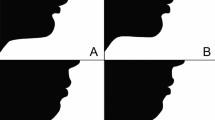Abstract
Objective:
The objective of this study was to answer the following questions: Are profiles of Class I patients perceived as more attractive than profiles of Class II or Class III patients in Germany today? How pronounced must a skeletal malocclusion be to be perceived as less attractive? Are there differences in perception between dentists and laypersons?
Material and Method:
For the present study we examined seven patients with skeletal Class I, orthognathic maxillae and mandibles, and straight average faces (ideal biometric face as defined by A. M. Schwarz). Using the Onyx Ceph™ software, their profile lines were modified to reflect three different Class II profile variants and three different Class III profile variants. The 49 profiles thus obtained were assigned to two groups. Group 1 comprised the seven straight average faces and the first part of the retrognathic and prognathic profile variants. Group 2 comprised the same seven straight average faces and the remaining retrognathic and prognathic profile variants. Both groups of faces were scored by 130 laypersons and 126 dentists.
Results:
Both groups of observers perceived the seven straight average faces similarly both in the first and second (subsequent) scoring rounds. The straight average face was perceived as most attractive by laypersons (mean, 5.48; 95% confidence interval (CI:) 5.33–5.60) and dentists (mean, 5.44; 95% CI, 5.28–5.50) alike, followed by the mildest variant of the retrognathic face (laypersons, mean, 4.85; 95% CI, 4.68–5.01; dentists, mean, 4.98; 95% CI, 4.81–5.10). Dentists differentiated more clearly by degree of skeletal malocclusion than did laypersons. Both groups alike perceived the extreme variant of the prognathic and retrognathic profile lines as the least attractive. Grouping the subjects by gender yielded only minor differences in perception.
Conclusion:
The straight average face is perceived as most attractive by representative German populations today. Dentists make clearer gradual distinctions in their perceptions than do laypersons.
Zusammenfassung
Fragestellung:
Ziel dieser Studie war die Beantwortung folgender Fragestellungen: Werden heutzutage in Deutschland Profilansichten von Klasse-I-Patienten als attraktiver bewertet als Klasse-II- und Klasse-III-Patienten? Ab welcher skelettalen Anomalieausprägung wird ein Profil als weniger attraktiv empfunden? Gibt es Unterschiede in der Beurteilung zwischen Zahnmedizinern und Laien?
Material und Methode:
Sieben skelettale Klasse-I-Patienten mit orthognathem Oberkiefer sowie Unterkiefer und Biometgesicht (gerades Mittelwertgesicht nach A. M. Schwarz) wurden mit Hilfe des Computerprogramms Onyx Ceph™ in jeweils drei Klasse-II- und drei Klasse-III-Profilvarianten mit unterschiedlich starker Ausprägung verwandelt. Die so entstandenen 49 Profile wurden in zwei Gruppen aufgeteilt. Die erste Gruppe umfasste die sieben Biometgesichter und den ersten Teil der retrognathen und prognathen Profilverläufe. Die zweite Gruppe bestand ebenfalls aus den gleichen sieben Biometgesichtern sowie den restlichen prognathen und retrognathen Formen. Beide Gesichtsgruppen wurden von 130 Laien und 126 Zahnmedizinern beurteilt.
Ergebnisse:
Beide Beurteilergruppen beurteilten die sieben Biometgesichter in der ersten und der später folgenden zweiten Bewertung ähnlich. Das Biometgesicht wurde von den Laien (MW: 5,48, 95% Vertrauensintervall (VI) 5,33–5,60) sowie von den Zahnmedizinern (ZM) (MW: 5,44, 95% VI 5,28–5,50) als am attraktivsten beurteilt, direkt gefolgt von der leichtesten Ausprägung des nach hinten schiefen Profilverlaufs (Laien: MW: 4,85, 95% VI 4,68–5,01; ZM: MW: 4,98, 95% VI 4,81–5,10). Die Zahnmediziner stuften deutlicher nach Schweregrad der Abweichung ab als die Laien. Übereinstimmend bewerteten beide Gruppen die extreme Ausprägung des nach vorne und hinten schiefen Profilverlaufs als am unattraktivsten. Die Unterteilung der Probanden in Männer und Frauen ergab nur geringe Unterschiede in der Beurteilung.
Schlussfolgerung:
Das Biometgesicht wird heutzutage in Deutschland von repräsentativen Populationen als am attraktivsten beurteilt. Zahnmediziner beurteilen mit deutlicheren graduellen Unterschieden als Laien.
Similar content being viewed by others
Author information
Authors and Affiliations
Corresponding author
Rights and permissions
About this article
Cite this article
Hönn, M., Dietz, K., Godt, A. et al. Perceived Relative Attractiveness of Facial Profiles with Varying Degrees of Skeletal Anomalies. J Orofac Orthop 66, 187–196 (2005). https://doi.org/10.1007/s00056-005-0445-0
Received:
Accepted:
Issue Date:
DOI: https://doi.org/10.1007/s00056-005-0445-0




